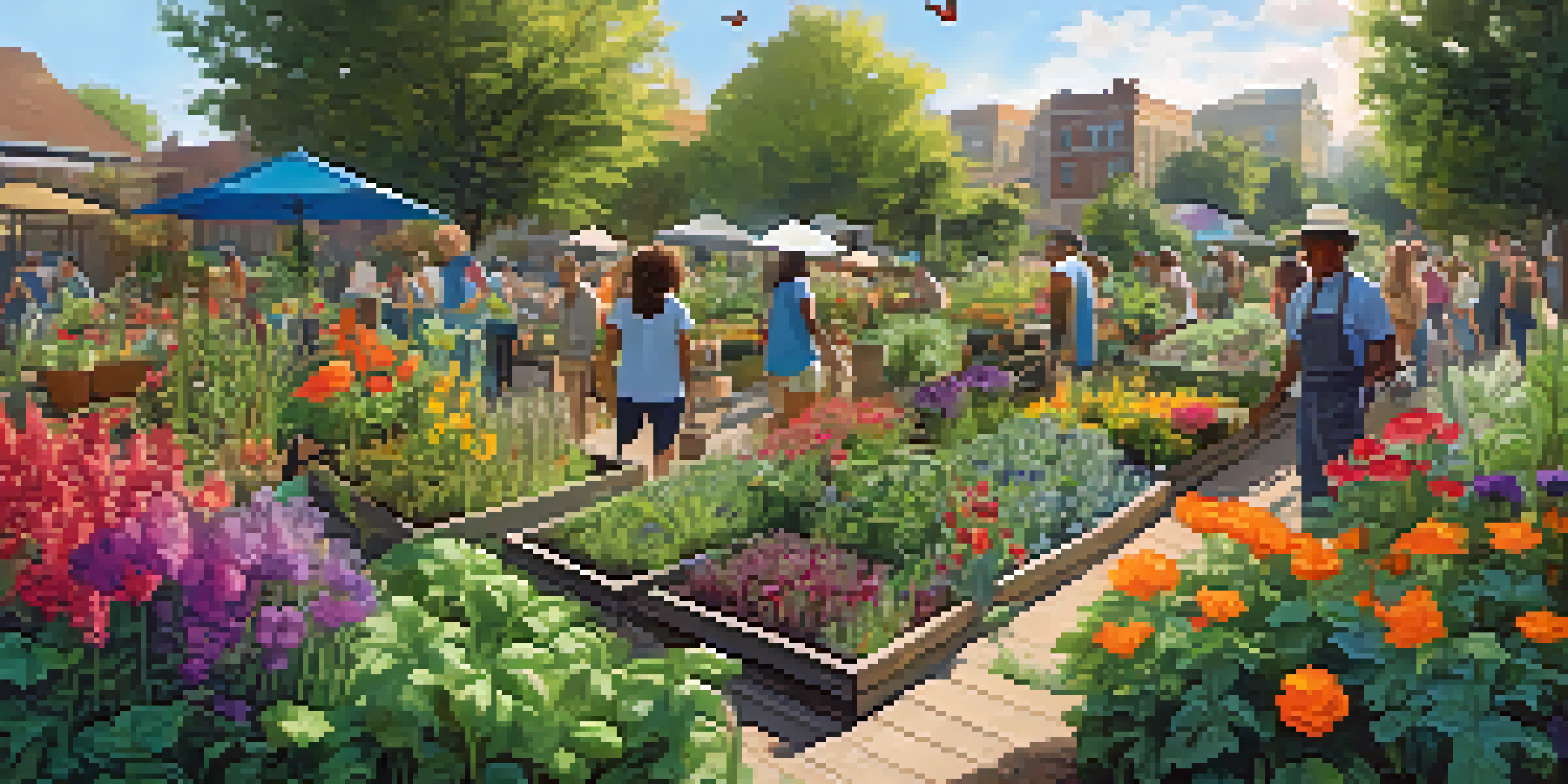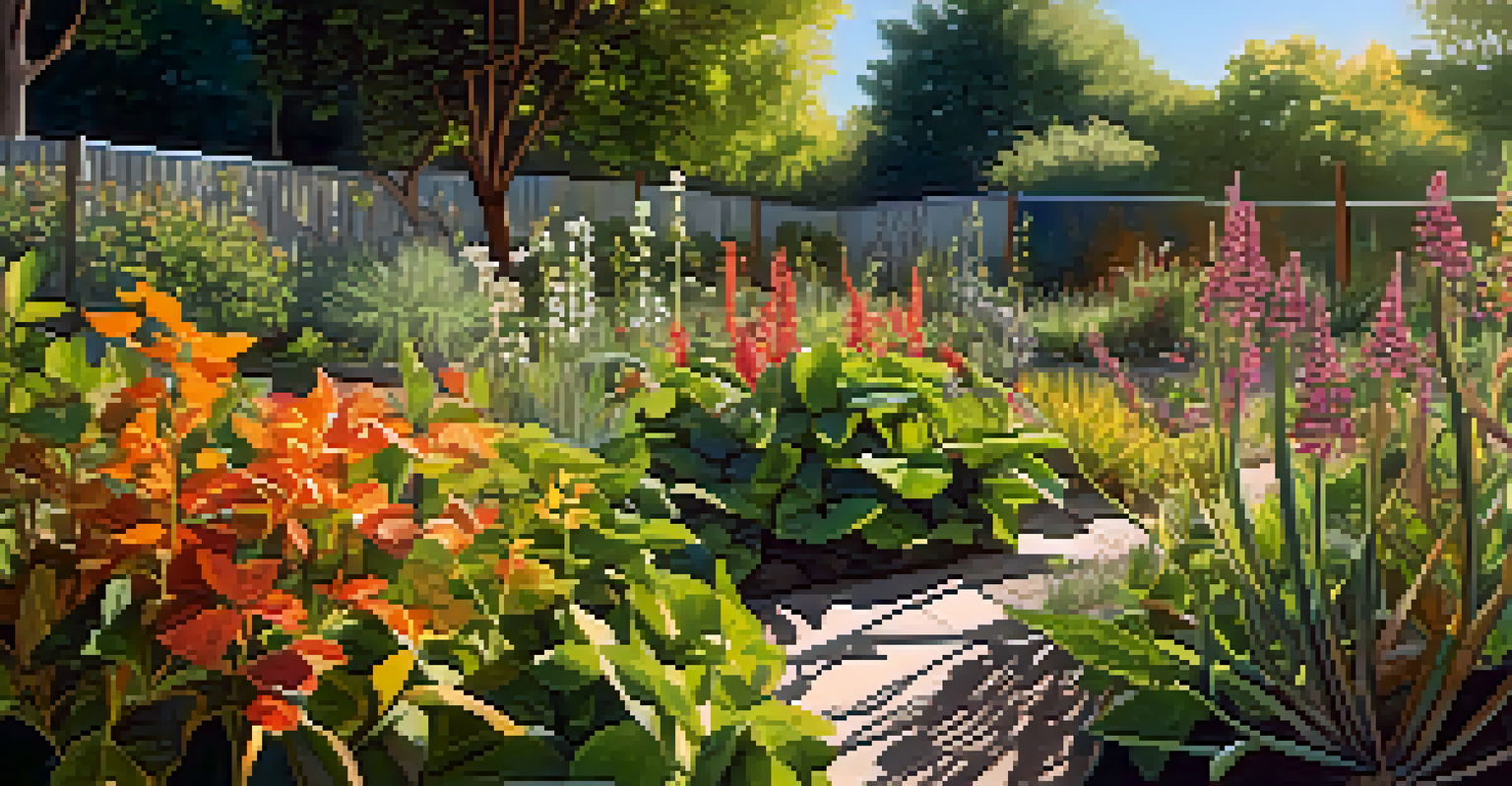The Role of Community Gardens in Enhancing Urban Plant Diversity

Understanding Urban Plant Diversity and Its Importance
Urban plant diversity refers to the variety of plant species found in city environments. This diversity is crucial because it supports local ecosystems, provides habitats for wildlife, and enhances the overall beauty of urban landscapes. Just like a diverse menu at a restaurant offers something for everyone, a varied plant life ensures that urban areas can thrive in ecological balance.
The best time to plant a tree was twenty years ago. The second best time is now.
Moreover, urban plant diversity plays a role in climate resilience. Different plant species have unique abilities to adapt to weather changes, which can help cities withstand extreme conditions like heat waves and heavy rainfall. When cities embrace a variety of plants, they are essentially building a fortress against climate change, much like how a diverse team can tackle challenges more effectively.
Community gardens serve as a microcosm of this diversity, showcasing a wide range of plants that might not be found elsewhere in the concrete jungle. These gardens are not just about growing food; they are about cultivating a rich tapestry of life that benefits both people and the environment.
How Community Gardens Contribute to Plant Diversity
Community gardens are like living laboratories for plant diversity. They encourage local residents to cultivate various species, from vegetables to ornamental plants, which enriches the urban ecosystem. By providing a space for different plants to flourish, these gardens enhance the overall biodiversity of the area, making cities more vibrant and resilient.

In addition, community gardens often promote the use of native plants, which are essential for maintaining local ecosystems. Native plants are adapted to the local climate and soil conditions, requiring less water and care than non-native species. This approach not only preserves local flora but also attracts pollinators and beneficial insects, creating a balanced environment.
Urban Gardens Boost Plant Diversity
Community gardens enhance urban plant diversity by providing spaces for various species to thrive and promoting native plants.
Furthermore, these gardens are spaces for knowledge sharing, where experienced gardeners can teach others about the benefits of diverse planting. This exchange of information fosters a deeper appreciation for the importance of plant variety in urban settings, ultimately leading to a greener, more sustainable community.
The Social and Ecological Benefits of Community Gardens
Community gardens are not just about the plants; they also cultivate social connections among residents. When people come together to garden, they share stories, resources, and knowledge, strengthening community bonds. This social interaction is vital in urban settings where isolation can be common, making these gardens a hub of engagement and connection.
The greatest threat to our planet is the belief that someone else will save it.
Ecologically, these gardens contribute to improved air quality and reduced urban heat. Plants absorb carbon dioxide and release oxygen, making the air cleaner for everyone. Additionally, by providing green spaces, community gardens help combat the urban heat island effect, where cities become significantly warmer than their rural surroundings.
These ecological benefits extend beyond the gardens themselves. When community members are invested in their local environment, they are more likely to advocate for sustainable practices and policies. This ripple effect can lead to larger-scale changes in urban planning, benefiting not just the gardens but the entire city.
Challenges Faced by Community Gardens in Urban Areas
Despite their numerous benefits, community gardens often face challenges that can hinder their growth and sustainability. One significant issue is land access; in many urban areas, available land is scarce and expensive. Gardeners often have to navigate complex zoning laws and property ownership issues to establish and maintain these green spaces.
Another challenge is the variability in community involvement. While some gardens thrive due to active participation, others struggle when community interest wanes. This fluctuation can impact the garden's overall health and diversity, making it essential for organizers to continuously engage and motivate participants.
Community Bonds Through Gardening
These gardens foster social connections among residents, creating a sense of community and shared responsibility for the environment.
Additionally, funding can be a hurdle. Many community gardens rely on donations and grants, which can be unpredictable. Without consistent financial support, gardens may face difficulties in acquiring necessary resources, from seeds to tools, limiting their potential to enhance urban plant diversity.
The Role of Education in Community Gardens
Education plays a pivotal role in the success of community gardens. These spaces often serve as outdoor classrooms, where individuals of all ages can learn about horticulture, sustainability, and the environment. Workshops and hands-on activities help demystify gardening, making it accessible and enjoyable for everyone.
Moreover, educational programs can foster a sense of stewardship for the environment. When people understand the importance of plant diversity and the role it plays in ecological health, they are more likely to engage in conservation efforts. This knowledge empowers individuals to take action, whether in their gardens or in broader community initiatives.
By integrating education into community gardens, these spaces become catalysts for change, inspiring participants to advocate for greener practices and policies. This ripple effect can lead to a more environmentally-conscious population that values and protects urban biodiversity.
Community Gardens as Catalysts for Urban Green Spaces
Community gardens are often the first step in a larger movement towards increasing urban green spaces. By transforming vacant lots and neglected areas into lush gardens, they demonstrate the potential for greener environments. This transformation not only beautifies neighborhoods but also inspires local governments and organizations to invest in more green spaces.
As more people recognize the benefits of urban gardening, there is a growing push for policies that support the establishment and maintenance of community gardens. This can lead to initiatives that promote green roofs, park enhancements, and more community-led projects. By advocating for these changes, community gardens help reshape urban landscapes into healthier, more sustainable environments.
Education Drives Garden Success
Educational programs in community gardens empower individuals to engage in sustainable practices, promoting environmental stewardship.
Additionally, the visibility of these gardens can spark interest in gardening among those who may not have considered it before. As people see the beauty and benefits of these green spaces, they may be inspired to create their own gardens or support local gardening initiatives, further enhancing urban plant diversity.
The Future of Community Gardens and Urban Plant Diversity
Looking ahead, the future of community gardens is bright, particularly in their capacity to enhance urban plant diversity. As cities continue to grow, the need for green spaces will only increase, and community gardens will play a crucial role in meeting this demand. With ongoing support from local communities, governments, and organizations, these gardens can flourish and expand.
Innovative strategies, such as vertical gardens and rooftop gardening, can also complement traditional community gardens, maximizing the use of limited urban space. These approaches can introduce even more plant species into urban areas, contributing to a richer tapestry of biodiversity. Imagine a city where not just parks, but buildings, are adorned with greenery.

Ultimately, community gardens represent hope for urban ecosystems. They remind us that even in the heart of concrete jungles, we can cultivate life, diversity, and community. By embracing and supporting these gardens, we take an important step toward a greener, more sustainable future for all urban dwellers.